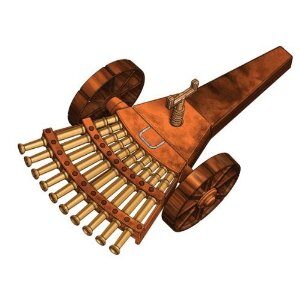
Leonardo da Vinci machine gun model
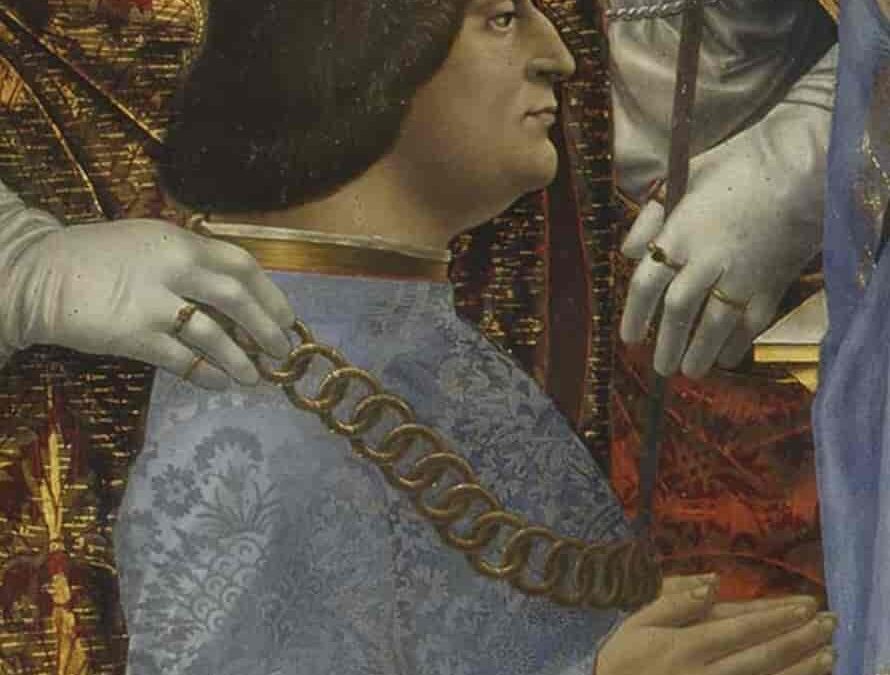
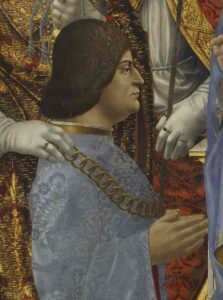
Ludovico Sforza (1452-1508)
Ludovico Sforza, known as “Il Moro,” was a significant figure in Renaissance Italy. He was renowned for his patronage of the arts and tumultuous reign as the Duke of Milan from 1494 to 1499. This article will offer you insights into his achievements and challenges.
By the end of this read, you will understand Sforza’s pivotal role and influence on famous artists like Leonardo da Vinci.
As a member of the Sforza dynasty, Ludovico was instrumental in transforming Milan into a vibrant center of cultural and technological advancement. He sponsored numerous projects, such as engineering endeavors and artistic commissions, that left a lasting legacy on the city’s heritage.
Ludovico Sforza is perhaps best remembered for his support of Leonardo da Vinci, whose iconic works, such as “The Last Supper,” were created during Sforza’s rule.
Despite his contributions, Ludovico’s reign was marked by political strife and alliances, eventually leading to his downfall. Competing interests from France and the Holy Roman Empire created a turbulent environment, challenging his leadership and ultimately leading to his capture.
For more on the complex history of the House of Sforza, his legacy provides a compelling study of power, art, and ambition in Renaissance Europe.
Ludovico Sforza was a key figure in late 15th-century Italian politics and a renowned arts patron. Throughout his life, he navigated complex family dynamics and Italian politics to secure power as the Duke of Milan.
Ludovico Maria Sforza was born on July 27, 1452, in Vigevano, part of the Duchy of Milan. He was the son of Francesco Sforza, a leading military commander-turned-Duke, and Bianca Maria Visconti.
As part of the influential Sforza family, Ludovico was involved in the political intricacies of the time from a young age. Being the fourth son, he was initially not seen as an heir to the duchy.
Despite this, his ambition and intelligence positioned him for eventual leadership. His family ties and early connections with important figures throughout Italy were vital in his future ascent to power.
Ludovico’s education focused on the humanistic ideals of the Renaissance, emphasizing arts and politics. Growing up surrounded by Renaissance art and culture, he developed a passion for artistic patronage.
His early influencers included scholars and artists such as Leonardo da Vinci, whose work in Milan shaped both Ludovico’s artistic tastes and political strategies.
He cultivated relationships with thinkers and artists, which later benefited his rule. These connections supported Ludovico’s political maneuvers and helped solidify his power base.
Despite being Francesco Sforza’s fourth son, Ludovico skillfully navigated the political landscape to claim the title of Duke of Milan. After his elder brother Galeazzo Maria Sforza’s assassination, Ludovico became involved in the regency, strategically outmaneuvering his nephews in the power struggle.
By 1494, he positioned himself as the duchy’s powerhouse. He officially assumed the role of Duke amid complex alliances and rivalries, including those with the French and Habsburg (Maximilian I of Austria). He secured his rule by exploiting external pressures from European powers.
This strategic ascent marked a significant period in Milanese history, with Ludovico leaving a lasting impact through his rule and patronizing the arts.
Ludovico Sforza played a complex role during his tenure as Duke of Milan. His reign included solidifying power, enforcing new policies, and interacting strategically with other Italian states.
Ludovico Sforza, the Duke of Milan, rose to power during a turbulent time in Italian history. As the fourth son, he wasn’t originally expected to rule. He significantly increased his influence through strategic marriages and alliances, such as his bond with Caterina Sforza.
He secured support from important figures, employing clever political maneuvers to establish his dominion. His leadership was solidified when he was declared regent for his young nephew, further tightening his control over Milan. This period marked a significant power shift, enabling Ludovico to implement his ambitious plans.
Cultural and economic advancements characterized Ludovico’s governance. He supported Leonardo da Vinci as an arts patron, commissioning works like “The Last Supper” and contributing to Milan’s cultural richness.
He also invested in agricultural innovations and irrigation projects, enhancing the region’s economic well-being. His vision and support for the arts and science ushered in a prosperous era, indicative of his influence across various facets of life in Milan. This approach was crucial in maintaining the city’s status as a Renaissance hub.
Ludovico maintained a delicate balance in his relations with other Italian states. He sought to expand his influence beyond Milan through strategic alliances and warfare. His interactions with France were pivotal, as they offered opportunities and challenges.
Despite his diplomatic efforts, conflict with France eventually led to Milan’s occupation, and Ludovico’s eventual capture and imprisonment highlighted the volatile nature of Italian politics. His reign exemplified the intricate web of allegiances and rivalries that defined the Italian states during this period.
Duke of Milan, Ludovico Sforza, significantly influenced the Renaissance through his art patronage. His support for artists like Leonardo da Vinci and investment in cultural projects like the Sforza Castle contributed to Milan’s status as a key cultural hub during this period.
Ludovico Sforza was instrumental in supporting Leonardo da Vinci’s works. As a patron, he enabled da Vinci to pursue various artistic and scientific endeavors, which were crucial in creating masterpieces such as The Last Supper.
A mutual appreciation for innovation marked the partnership between Sforza and da Vinci. Sforza provided da Vinci with resources and opportunities to apply his talents in art and engineering projects.
This relationship exemplifies how influential patrons like Sforza could foster the careers of great artists during the Renaissance.
Under Ludovico’s rule, the Sforza Castle in Milan became a center of cultural enhancement. He funded extensive renovations, making the castle a symbol of Milanese power and culture. These projects included hiring renowned artists and architects to redesign and expand the structure.
The castle didn’t just serve as a fortress but also as a vibrant hub for artistic expression. It hosted various activities, from musical performances to art exhibitions, reflecting Sforza’s ambition to position Milan as a cultural leader. This investment in cultural projects also had lasting effects, as elements of the castle can still be admired today.
The impact of Ludovico Sforza’s patronage on Renaissance art was profound. By supporting artists like Leonardo da Vinci and commissioning grand architectural projects, he helped Milan emerge as a Renaissance powerhouse. This patronage allowed for the creation of iconic artwork and significant advancements in artistic techniques.
His influence extended beyond individual artists to the broader art community, encouraging a culture that valued creativity and excellence. This focus on the arts contributed to the spread of European Renaissance ideals and reinforced Milan’s reputation as a cradle of creativity and innovation.
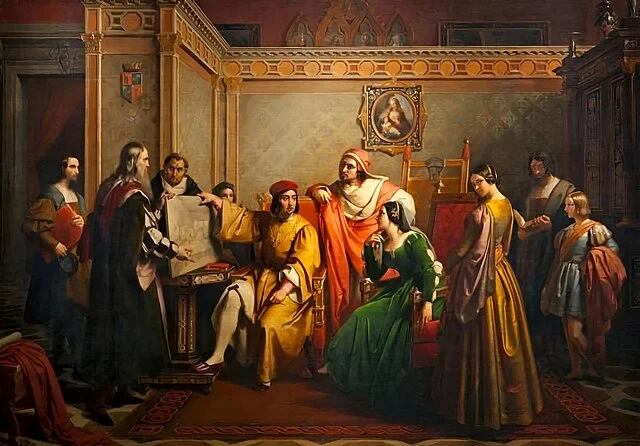
Leonardo da Vinci presents his Last Supper sketch to Duke Ludovico il Moro. At the center are the Duke, Duchess Beatrice, and Cardinal Ascanio, as depicted by Francesco Podesti in 1846.
One of Ludovico Sforza’s most enduring legacies was his patronage of the polymath genius Leonardo da Vinci. Recognizing Leonardo’s unmatched talent, Ludovico invited him to Milan in 1482. This planned move was not merely about collecting art; it was a strategic endeavor to augment the cultural prestige of his court and city.
Under Sforza’s patronage, Leonardo da Vinci flourished as a painter, sculptor, architect, engineer, and scientist. In addition to producing iconic art, Leonardo was involved in several projects, from developing military strategies to designing canal systems. His diverse roles under Ludovico’s rule showcased his talents far beyond the realm of painting.
Leonardo’s tenure in Milan under Ludovico’s patronage led to the conception of several groundbreaking projects and inventions. His works spanned numerous disciplines, including civil engineering, aeronautics, and military science. His sketches of ‘flying machines’ inspired future generations of aviation, while his designs for war machines revolutionized military engineering.
While serving Ludovico, Leonardo da Vinci created some of his most celebrated works. These include the iconic ‘The Last Supper,’ a mural that continues to captivate audiences with its emotional depth and compositional innovation. Leonardo also began the monumental project of a horse statue, known as the ‘Gran Cavallo,’ which, although never completed, symbolized the ambition and grandeur of the Sforza court.
Another notable work is the ‘Madonna Litta,’ a testament to Leonardo’s mastery of portraying human emotion. The Codex Atlanticus, a collection of Leonardo’s drawings and writings compiled during his time in Milan, is an extraordinary record of Renaissance ideas.
Ludovico Sforza, known as Ludovico il Moro, was deeply involved in the military and political turmoil of the Italian Wars. His strategic alliances and conflicts significantly impacted the Duchy of Milan.
The Italian Wars, beginning in the late 15th century, saw Ludovico Sforza’s significant involvement as a key figure. He allied with Charles VIII of France to secure his position in Milan.
This alliance, though strategic, led to a series of conflicts across Italy. Ludovico’s shifting allegiances were instrumental in forming the League of Venice, which aimed to push French forces out of Italy.
His involvement in these wars was marked by military maneuvers and diplomatic negotiations to maintain Milan’s independence and power.
Ludovico Sforza engaged in complex alliances and rivalries as the Duke of Milan. His initial support for French forces turned against him, leading to partnerships with other Italian states and Spain.
The fluctuating allegiances created numerous adversaries and friends. Notably, his rivalry with the Republic of Venice was significant.
He was also known for his diplomatic relations with Maximilian in the Holy Roman Empire. These alliances and rivalries were strategic moves to retain authority in Milan amidst European power struggles.
The defense of Milan was a priority for Ludovico Sforza, particularly during France’s attempts to assert control.
As Duke, Ludovico fortified Milan against external threats. His military tactics and investments in fortifications, such as the castle in Milan, were crucial in defending the city.
Milan eventually fell to French forces in the Battle of Novara despite his efforts, leading to his capture. His time as Duke was characterized by a relentless defense of Milan, highlighting his commitment to retaining its regional autonomy and influence.
Ludovico Sforza encountered significant challenges in maintaining power during the late 15th century. His eventual capture and imprisonment marked the end of his rule and had lasting effects on his legacy.
In 1499, Ludovico Sforza, often called Ludovico il Moro, faced an invasion by French forces led by King Louis XII. Seeking to reclaim Milan, Louis had a strong claim through his grandmother, Valentina Visconti.
Ludovico attempted to recruit Swiss mercenaries to defend his position. Despite these efforts, the French army proved too strong.
By April 1500, Ludovico was captured after being betrayed by his Swiss troops. This marked a significant turning point in Milan’s history, ending Ludovico’s rule and altering the region’s political landscape.
Once captured, Ludovico Sforza was imprisoned in the Château de Loches in France. His life in captivity was one of isolation and despair. He spent almost eight years there until he died in 1508.
During this time, he was largely cut off from the outside world, which weighed heavily on him.
Despite his situation, Ludovico remained a figure of intrigue. He was recognized for his earlier role as a patron of the arts, notably supporting Leonardo da Vinci.
The isolation didn’t overshadow his contributions to the Italian Renaissance, though his direct influence waned during these years.
Ludovico Sforza’s legacy endured well beyond his death in 1508. Often remembered for his patronage of Leonardo da Vinci, his rule was marked by cultural achievements, including da Vinci’s renowned “The Last Supper.”
Ludovico’s impact on Milan’s artistic and political environment remained significant despite his downfall. His descendants, including Francesco II Sforza, carried on the Sforza name, though they did not achieve the same power level.
Today, his contributions to art and culture are still celebrated, while the Sforza family remains a topic of historical interest.

Ludovico Sforza receives the Imperial fief of Milan from Maximilian, with Bianca Maria as his consort.
Ludovico Sforza had complex personal ties that shaped his reign. His marriages, communications with notable figures, and the impact on his descendants showcase his influence during the Italian Renaissance.
Ludovico Sforza married Beatrice d’Este in a politically motivated union. Their marriage was significant, aligning two powerful families.
They had two sons, Maximilian and Francesco II Sforza. Their offspring played key roles in Milan’s politics, especially during tumultuous succession disputes.
Additionally, Ludovico maintained a liaison with Lucrezia Crivelli, resulting in another son, Giovanni Paolo I Sforza.
These connections, both formal and informal, solidified Ludovico’s standing among the Italian nobility and impacted Milan’s history.
Ludovico Sforza engaged in numerous correspondences, notably with Leonardo da Vinci. His letter to Ludovico requesting employment illustrates the duke’s influence as a patron.
Renowned for his diplomatic acumen, Ludovico was pragmatic and resilient. Despite political challenges, including French threats to his rule, he exhibited impressive strategic skills.
These traits, combined with his intellectual pursuits, underscored his ability to navigate and manipulate the political landscape of Renaissance Italy.
Ludovico Sforza’s lineage, known as “the Moor” due to his dark complexion, continued to exert influence long after his death. His sons, especially Francesco II, contributed to political transitions within Milan.
Despite eventual decline, the Sforza family remains notable for their Renaissance contributions.
Ludovico’s descendants endured through strategic marriages and alliances, albeit with diminishing power. This legacy is marked by their enduring cultural and political residues in Italian history.
Ludovico Sforza, known as “Il Moro,” has influenced historical and cultural narratives. His role as a patron of the arts and his tumultuous reign in Milan offer rich material for artistic and scholarly exploration.
Ludovico Sforza is a profound presence in literature and art. His close relationship with Leonardo da Vinci highlights his significant role as a patron.
One notable example is Leonardo da Vinci’s “The Last Supper,” commissioned under his patronage and remains a pinnacle of Renaissance art.
Literature often portrays him as a complex figure who mixes ambition with vulnerability. His character appears in historical novels, and his political maneuvers and court life are dramatized in series like The Borgias.
The nickname “Il Moro,” meaning “The Moor,” adds intrigue and identity to his portrayals.
Recent historical studies have reevaluated Ludovico Sforza’s impact on Milan and the Renaissance. Known also as Ludovico Il Moro, scholars debate his leadership effectiveness and cultural contributions.
Modern historians highlight his patronage of artists, notably da Vinci, and his role in transforming Milan into a cultural hub.
Recent discoveries support the meticulous planning reflected in his strategies for fortification and involvement in secret passages and tunnels.
While his political endeavors ended in imprisonment and death, his legacy in the arts and architecture continues to be reassessed, emphasizing his contributions to the Milanese Renaissance and beyond.
Ludovico Sforza was a significant patron of the arts during the Italian Renaissance. His support attracted notable artists, including Leonardo da Vinci.
As the Duke of Milan, Ludovico commissioned ambitious projects like the renowned Last Supper mural. This commission reflects his commitment to cultural patronage.
Despite setbacks, such as political struggles and the eventual fall of Milan to French forces, he left a lasting mark on Milan’s artistic landscape.
His leadership fostered a culturally rich environment during a pivotal time in history.
Ludovico Sforza played a significant role as the Duke of Milan during the Renaissance, influencing politics and the arts. His connections with figures like Leonardo da Vinci and the cultural developments during his time mark key aspects of his legacy.
Ludovico Sforza was a pivotal Duke of Milan figure known for fostering Renaissance art and culture. He patronized artists like Leonardo da Vinci, which helped make Milan a center of Renaissance culture. His political maneuvers and ambitions also impacted the Italian peninsula.
Ludovico Sforza, also known as Ludovico il Moro, was the Duke of Milan. He ruled from 1494 to 1499 and was notable for his patronage of the arts and efforts to strengthen Milan’s political power. He was incredibly influential in the development of early modern military tactics.
Once mighty in Milan, the Sforza family diminished in political influence over the centuries. While the family does not hold the power it once did, descendants of the Sforza family still exist today, but they are less prominent in contemporary public affairs.
Leonardo da Vinci impressed Ludovico Sforza with his diverse art, science, and engineering talents. His detailed art and innovative designs captivated Ludovico, who became his patron. Notably, da Vinci painted the iconic “The Last Supper” during his time with Ludovico.
Leonardo da Vinci’s patron for “The Last Supper” was Ludovico Sforza. This commission was completed while da Vinci worked in Milan and under Ludovico’s patronage. The painting is regarded as one of Leonardo’s masterpieces.
The series Medici fictionalizes Ludovico Sforza and dramatizes events for historical narrative. However, the show does not provide a historically accurate account of who killed Sforza. Historically, Ludovico Sforza was imprisoned by the French and died in captivity.
Leonardo da Vinci stayed in the court of Ludovico Sforza from 1482 to 1499, a period of about 17 years, during which time he produced some of his most famous works, including “The Last Supper.” His extended stay in Milan marks a significant period in his career.
In “Medici,” Ludovico Sforza is portrayed as a strategic and ambitious Duke of Milan. His character reflects his historical role in Italian politics and his artistic patronage. The show’s portrayal is dramatized but provides insight into his influence during the Renaissance.
Leonardo da Vinci’s patron in Florence was Lorenzo de’ Medici. Lorenzo was a member of the powerful Medici family, known for supporting artists and intellectuals. Lorenzo recommended Leonardo to work in Milan under Ludovico Sforza’s patronage.
Ludovico Sforza commissioned “The Last Supper” to enhance Milan’s artistic and cultural standing. The painting was intended for the refectory of the Convent of Santa Maria delle Grazie and reflected Ludovico’s desire to leave a lasting cultural legacy.
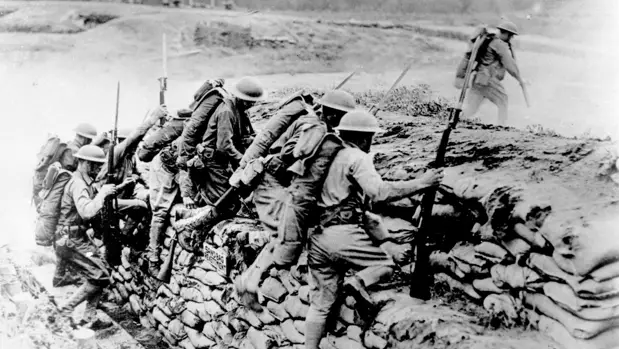

World War 1 (1914-1918)
World War I started in 1914, marking the beginning of a global conflict that involved many of the world’s great powers.
The war officially began on July 28, 1914, when Austria-Hungary declared war on Serbia.
This assassination set off a chain reaction among alliances and countries, pulling nations into a war that would last until 1918.
You’re not alone if you have ever wondered how a single event led to a war of such magnitude. This blog post aims to unravel the complexities surrounding the start of World War I and help you understand how political alliances and national tensions contributed to the outbreak of this massive conflict.
The assassination of Archduke Franz Ferdinand was a key moment, setting off a series of declarations that expanded into a worldwide battle. This conflict saw countries like Germany, Austria-Hungary, France, and the United Kingdom face off.
The details of each nation’s participation in the war reveal fascinating insights into the political climate of the early 20th century.
World War I was a global conflict that reshaped many countries. It involved multiple key events and dates that marked significant moments in history. These elements help paint a clear picture of how the war unfolded and its impact.
World War I, also known as the Great War, began on July 28, 1914. The immediate trigger was the assassination of Archduke Franz Ferdinand of Austria, but deeper issues like nationalism and alliances played a role. When Austria-Hungary declared war on Serbia, it set off a chain reaction.
Countries across Europe quickly took sides, leading to a large-scale war until 1918.
Table 1 outlines several key events that defined World War I.
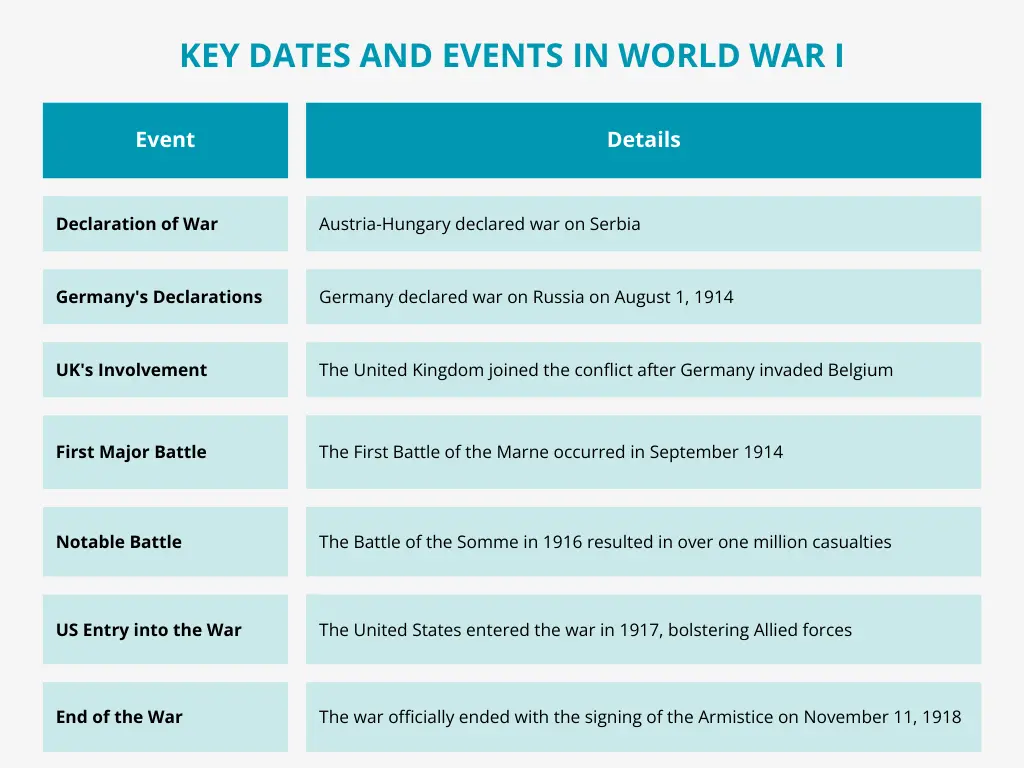
World War I lasted four years, from 1914 to 1918, and was marked by some of the bloodiest battles in history. The end of the war, on November 11, 1918, marked the beginning of a worldwide push for peace and diplomacy.
Many countries involved in World War I were also part of World War II, as unresolved issues and new challenges arose.
The First World War changed political landscapes and societies. Its aftermath paved the way for significant changes in national borders and the creation of new nations. This war’s timeline offers insight into the complexities and impact of global conflict.
A complex web of alliances, national tensions, and significant events marked World War I. These causes intertwined to create the backdrop for a devastating conflict that reshaped the world.
The beginning of World War I, or the Great War, on July 28, 1914, can be traced back to a mix of political, military, and social tensions. Nationalism played a key role as countries sought to assert their superiority and independence.
This was particularly true in Europe, where the balance of power was fragile.
Economic rivalries and competition for colonies added fuel to the fire. Industrialized nations were eager to expand their empires and influence, creating friction.
The opposing ambitions of these nations set the stage for conflict.
Alliances played a significant part in escalating regional disputes into a full-scale war.
These alliances were meant to deter aggression, but instead, they created a situation in which a conflict involving one country could quickly draw in its allies. This interconnectedness made localized conflicts more dangerous.
Tensions in the Balkans, known as the “Powder Keg of Europe,” were particularly explosive. Austria-Hungary and Russia’s desire for greater regional influence heightened the risk of confrontation. This rivalry contributed significantly to the onset of hostilities.
The assassination of Archduke Franz Ferdinand of Austria-Hungary on June 28, 1914, is often seen as the immediate catalyst for World War I. Gavrilo Princip, a Bosnian Serb nationalist, assassinated with the hope of promoting Slavic independence.
Austria-Hungary’s response was swift and aggressive. They issued an ultimatum to Serbia, and when Serbia’s response was seen as unsatisfactory, Austria-Hungary declared war, prompting Russia to mobilize in support of Serbia.
This assassination triggered a series of events that led the major powers into a spiraling conflict. The alliances and ambitions of these powers quickly fueled the flames of war, kicking off a global conflict that lasted for over four years.
World War I was a significant global conflict involving many countries and alliances. Key players emerged from two main sides: the Central Powers and the Allies, each led by influential figures and nations.
Several countries played critical roles during World War I. The Central Powers, led primarily by Germany, Austria-Hungary, and the Ottoman Empire, formed a formidable coalition against their adversaries.
On the opposing side, the Allies included major players like the United Kingdom, France, Russia, and the United States.
Other nations, like Italy and Japan, joined the Allies, contributing military and economic resources. Their involvement transformed regional conflicts into a full-scale global war.
The tensions from these alliances and rivalries eventually set the stage for another major conflict, World War II, in subsequent years.
The Central Powers and the Allies were the two main alliances during World War I.
The Central Powers comprised Germany, Austria-Hungary, and the Ottoman Empire. Mutual defense agreements and shared interests bound these nations.
In contrast, the Allies, initially formed by the Triple Entente, consisted of France, Russia, and the United Kingdom. Over time, this alliance expanded to include Italy, Japan, and the United States.
The combination of resources, manpower, and tactics eventually led to the Allies overcoming their opponents, solidifying their dominance by the end of World War I.
Woodrow Wilson served as President of the United States during World War I. Elected in 1912, his administration maintained a neutral stance as the war erupted in Europe.
However, the sinking of the Lusitania and other factors prompted him to enter the war in 1917, leading the United States to join the Allies.
Wilson’s leadership was crucial in shaping the post-war landscape. He outlined his vision for peace in his famous Fourteen Points, which emphasized self-determination and the formation of a League of Nations.
His efforts aimed to prevent future conflicts, though his vision was not fully realized until after World War II. His presidency left a lasting impact on international relations and the role of the United States in global affairs.
World War I involved massive shifts in warfare tactics and battles on multiple fronts, setting the stage for World War II. Technological advances changed how the war was fought and impacted the countries involved.
World War I showcased new military tactics and technologies that transformed combat. Trench warfare became a defining feature, with long, narrow trenches for soldiers to protect themselves from enemy fire. This static form of combat resulted in high casualties.
Machine guns, artillery, and gas attacks were standard, leading to devastating battlefield conditions. Tanks were introduced later in the war, providing a way to overcome trench defenses.
The war also saw the significant use of airplanes for reconnaissance and combat, marking the beginning of aerial warfare.
Naval warfare also played a critical role: submarines, particularly German U-boats, disrupted supply lines, impacting the war’s course.
Communication technology improved, with radio and telegraphs enhancing coordination among troops.
These innovations in tactics and technology played a central role in shaping the outcomes of the First World War.
World War I was fought mainly across Europe but also in other regions. The Western Front in France and Belgium saw some of the war’s heaviest fighting, with trench lines stretching for miles.
Battles such as the Somme and Verdun became synonymous with the brutal stalemate experienced by forces on both sides.
On the Eastern Front, the conflict between Germany and Russia was marked by fluid movement and significant territorial changes. The war extended to the Middle East, where the Ottoman Empire faced British-led forces.
The Italian Front and the Balkan Front further complicated the military landscape.
The global nature of the conflict meant that many nations outside of Europe, such as the United States, eventually joined the war, shifting the balance of power.
This involvement led to diverse strategies and battlegrounds across continents, making World War I a world war affecting numerous countries.
World War I laid the foundation for World War II, often considered a continuation of unresolved issues from the earlier conflict.
The harsh terms of the Treaty of Versailles, which ended the First World War, imposed heavy reparations and territorial losses on Germany. This generated significant resentment and economic hardship, contributing to the rise of Adolf Hitler and the Nazi Party.
The geopolitical landscape drastically changed with the dissolution of empires like Austria-Hungary and the Ottoman Empire. The League of Nations was formed to prevent future wars but failed in this mission, lacking enforcement power.
These post-war conditions and new political ideologies played a direct role in the onset of World War II. The end of the First World War did not bring lasting peace but set the stage for another devastating conflict 20 years later.
World War I significantly impacted global politics, economies, and societies. These changes influenced future conflicts, including World War II, and shaped the modern world.
The Allied Powers, which included France, the United Kingdom, and the United States, emerged victorious from World War I.
They fought against the Central Powers, which included Germany, Austria-Hungary, and the Ottoman Empire. The armistice signed on November 11, 1918, marked the formal end of the conflict.
The Allies faced extensive economic and social challenges despite their victory due to war-related devastation.
The victory was not only military but also diplomatic. The Allies secured agreements and treaties that would dictate post-war terms.
While the Central Powers were defeated, the conflict left much of Europe in ruins, leading to territorial boundaries and political structure shifts.
The Treaty of Versailles, signed in 1919, was a key outcome following WWI. It imposed harsh penalties and reparations on Germany, including large territorial losses, military restrictions, and substantial financial reparations.
The treaty aimed to prevent German aggression, but the strict conditions created economic hardship and resentment within Germany.
This discontent later fueled the rise of Adolf Hitler and the Nazi Party, contributing to the outbreak of World War II.
Many historians argue that the treaty’s punitive measures set the stage for future conflict. Although it intended to maintain peace, the treaty’s ramifications were long-lasting and complex, influencing the political landscape for decades.
WWI, often called the “Great War,” taught valuable lessons about warfare and diplomacy. It highlighted the devastating potential of modern weapons such as tanks and airplanes.
Strategies evolved to incorporate new technologies like machine guns and chemical weapons, changing how wars were fought.
Politically, the war encouraged the formation of international bodies designed to foster peace, such as the League of Nations. However, the league struggled with effectiveness, leading to changes in the establishment of the United Nations after World War II.
The conflict emphasized the need for diplomacy and cooperation to avoid such widespread destruction in the future. Understanding the consequences of the First World War remains crucial for preventing similar global conflicts.
World War I left a lasting impact on the world. It transformed military strategies and technologies and set the stage for future conflicts. The aftermath of the war is still commemorated worldwide through various memorials.
World War I introduced several innovations in warfare, marking a significant shift in military tactics and technologies. Trench warfare became a defining feature, with soldiers enduring harsh conditions on the front lines.
Tanks and airplanes were used for the first time, changing ground and aerial combat dynamics. This war also saw the introduction of chemical weapons, which had devastating effects on soldiers and prompted later bans.
Communication technology advanced, too, with wireless equipment and improved intelligence methods. These developments during World War I laid the groundwork for military tactics in future conflicts, including in World War II.
The outcome of World War I directly influenced the events leading to World War II. The Treaty of Versailles, which ended the first war, imposed harsh penalties on Germany, including significant territorial losses and reparations.
These conditions fueled economic hardship and political instability in Germany, creating fertile ground for the rise of Adolf Hitler and the Nazi Party. The grievances over the treaty’s terms were a driving force behind Germany’s militarization and expansionist policies.
Moreover, the geopolitical landscape was altered, creating new state borders and European tensions. This redrawing of maps and unresolved conflicts from World War I was key in generating the circumstances that caused World War II.
In the years following World War I, many countries built monuments and memorials honoring those who served and lost their lives. The annual observance of Armistice Day on November 11, marking the end of World War I, is a primary example of these commemorations.
Countries like the United Kingdom and France host solemn ceremonies to remember the sacrifices made by their soldiers.
Museums and memorials worldwide preserve artifacts and stories from the war. These sites ensure that the lessons and legacy of World War I remain a part of public consciousness, reminding current and future generations of the war’s enduring impact.
World War I marked a pivotal moment in global history. The conflict lasted from 1914 to 1918 and involved major world powers divided into the Allies and the Central Powers. The assassination of Archduke Franz Ferdinand in 1914 triggered a chain of events that led to the war’s outbreak.
The war’s impact was profound, leading to significant political shifts and laying the groundwork for future conflicts.
Key battles, such as the Battle of the Somme and Verdun, highlighted the brutal nature of trench warfare. The aftermath reshaped national borders and introduced technological advances in warfare.
Key Takeaways:
As the world looked to recover and rebuild, many lessons were learned that influenced the geopolitical landscape in the following years.
World War I was a complex conflict triggered by various factors. Primary causes include political alliances, territorial disputes, and the assassination of Archduke Franz Ferdinand. The war ended with significant consequences for the countries involved.
World War I began due to political, military, and nationalistic tensions. The assassination of Archduke Franz Ferdinand was a significant catalyst, alongside longstanding rivalries between major European powers. Complex alliances and treaties also played a critical role.
Germany’s involvement in World War II was primarily driven by Adolf Hitler’s aggressive expansionist policies and the desire to overturn the Treaty of Versailles. Hitler sought to establish German dominance in Europe, leading to the invasion of Poland in 1939, which triggered World War II.
Germany was mainly held responsible for World War I primarily because it supported Austria-Hungary after the assassination of Archduke Franz Ferdinand. The Treaty of Versailles, imposed on Germany after the war, stipulated harsh reparations and accountability due to their role in escalating the conflict.
The United States’ entry into the war in 1917 marked a turning point. The additional resources and manpower provided by the U.S. bolstered the Allies, leading to their eventual victory. Technological advancements and strategic innovations also shifted the tide in favor of the Allies.
The assassination of Archduke Franz Ferdinand of Austria-Hungary on June 28, 1914, served as the immediate trigger for World War I. He was killed by Gavrilo Princip, a Bosnian Serb nationalist, setting off a chain of events that led to the Great War.
The Allied Powers won World War I after several key victories and the successful blockade of the Central Powers’ resources. The armistice signed on November 11, 1918, marked the end of hostilities, as the Allies managed to push the Central Powers back after years of stalemate.
Russia suffered the most military and civilian casualties during World War I, with millions of soldiers and civilians dead or wounded. The country’s heavy losses resulted from several major battles on the Eastern Front and internal strife that led to the Russian Revolution.
The conflict started when Austria-Hungary declared war on Serbia in response to the assassination of Archduke Franz Ferdinand. Austria-Hungary’s actions, backed by Germany, led to a larger war involving multiple European powers due to pre-existing alliances.
While the assassination of Archduke Franz Ferdinand was the immediate trigger, tensions in Europe were already high. The intricate web of alliances and rivalries might have eventually led to war even without the assassination, but it was a decisive event that escalated those tensions.
The United States joined World War I due to several factors. These included Germany’s unrestricted submarine warfare, which threatened American ships. The discovery of the Zimmermann Telegram was also a factor. Germany tried to ally with Mexico against the United States in this telegram. American entry in 1917 significantly bolstered the Allied effort.
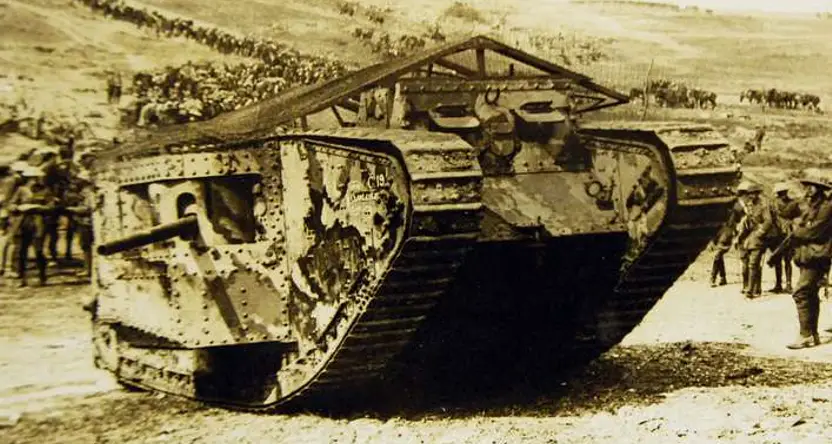

Mark I tank in World War 1
The Mark I Tank was the first operational tank in military history. This article will guide you through its development, design, and impact on World War I.
The Mark I Tank debuted during the Battle of the Somme in 1916, overcoming the harsh challenges of trench warfare and introducing a new era in combat.
This innovative armored vehicle featured a distinctive rhomboidal shape, which allowed it to traverse rugged terrains, including trenches and barbed wire.
Equipped with a 6-pounder cannon and side machine guns, the Mark I became a formidable presence on the battlefield, transforming military tactics globally.
Explore how the Mark I changed everything in armored warfare and beyond to understand the full story behind its creation and its profound impact.
The Mark I Tank, known for its groundbreaking design, became essential to warfare during World War 1. Its development involved various key figures and manufacturers; many of these tanks were produced for military use.
The origins of the Mark I Tank date back to the Landship Committee, which Lieutenant Walter Wilson and William Tritton led. They aimed to create a machine that could cross trenches and rough terrain.
The design emerged from issues identified in their earlier project, Little Willie, which struggled with movement and trench-crossing abilities.
To solve these problems, they developed a rhomboid shape and added extended tracks, improving its ability to navigate rugged terrains effectively.
The tank was also equipped with male and female variants, distinguishing them by armament types. This effort highlighted a significant innovation in military technology, marking the beginning of armored warfare.
Significant contributions from British companies were made to the production of the Mark I Tank. William Foster & Co. was critical in manufacturing these tanks after the initial prototype, known as “Mother” or “Big Willie.”
Around 150 Mark I tanks were built during its time, with variations in armaments and specific design features. These tanks first saw action on 15 September 1916 at the Battle of Flers-Courcelette, marking their debut in combat.
As more were produced, tanks became iconic parts of British military efforts during World War I, influencing future tank designs and strategies used by military forces worldwide.
The Mark I tank, introduced by the British in World War I, featured innovative elements such as advanced armor and a powerful engine, which were crucial for its operational success in the war.
The Mark I tank’s armor, which ranged from 6 to 12 mm in thickness, was designed to protect it against small arms fire and shrapnel.
This level of protection was vital for withstanding the conditions encountered during battles like the Battle of the Somme. The tank featured both male and female variants.
The male variant was equipped with two 6-pounder naval guns and four .303-inch Hotchkiss M1909 machine guns, while the female counterpart carried six Vickers .303 machine guns.
This dual variant design was a tactical response to varying combat roles, allowing the British Mark I tank to engage both infantry and fortified enemy positions effectively.
The Mark I was powered by a Daimler 6-cylinder petrol engine producing 105 horsepower. This engine enabled the tank to reach up to 3.7 mph on rough terrain, typical for World War 1 tanks.
The transmission system required a crew member to steer using a combination of brakes and gears. The tank’s tracks were a new development, essential for navigating the muddy and uneven battlegrounds.
Despite mechanical challenges and a high crew workload, the British Mark I tank 1916 proved its worth as a pioneering armored vehicle during WW1.
The Mark I Tank had a significant impact on WW1 combat. Its introduction marked a turning point in military tactics, paving the way for advances in armored vehicles in the following years.
The Mark I Tank was first deployed on September 15, 1916, during the Battle of Flers-Courcelette, part of the Somme Offensive. This battle marked the first time tanks were used in combat, aiming to break the trench warfare stalemate.
Out of 49 tanks shipped, only 32 engaged effectively due to mechanical failures. Despite these setbacks, the deployment showcased the tank’s potential to traverse rugged terrain and disrupt enemy lines.
The use of tanks during WW1 represented a bold shift in military strategy and British heavy tanks of the First World War.
On the battlefield, the Mark I Tank faced numerous challenges, including mechanical issues and vulnerability to artillery. Its tracks allowed it to cross trenches, but mud and rough terrain often caused breakdowns. The slow speed and limited armor made it susceptible to enemy fire.
Operated by an eight-person crew, the tank’s internal conditions were harsh, with extreme heat and fumes. Yet, the Mark I tank model demonstrated the potential of armored vehicles as effective tools in warfare by achieving surprise and confusion among German forces.
Following its initial deployment, the Mark I Tank underwent several modifications to improve performance. Changes included adjustments to the armor and mechanical systems to enhance reliability.
Variants known as “Male” and “Female” tanks featured different armaments; Males had two 6-pounder naval guns, while Females were equipped with machine guns.
Further developments led to the Mark I Tank being succeeded by improved models, such as the Mark IV, which addressed many initial shortcomings and significantly enhanced battlefield effectiveness.
The evolution of tanks during World War I was a testament to the rapid advancement in military technology, marked by incremental improvements and strategic variations. Among the most significant of these were the British Mark series tanks and the German tanks.
| Model | Key Features | Use in Combat |
|---|---|---|
| Mark I | First armored vehicle designed for frontline combat. | Used in World War I |
| Mark II | Slight modifications to the Mark I. Primarily used for training. | No combat usage |
| Mark III | Improved armor protection and better living conditions for the crew. | No combat usage |
| Mark IV | Thicker armor, improved fuel systems, and more reliable weaponry. | Used in World War I |
| Mark V | New transmission system for easier control and increased speed. | Used in World War I |
| Mark VI | Designed, but never made it past the prototype stage. | No combat usage |
| Mark VIII ‘Liberty’ | Thicker armor, more powerful engine, a collaborative effort with America. | No combat usage during World War I, but used later |
The Mark I Tank revolutionized military tactics during World War I, significantly changing battlefield strategies and future tank designs. Its introduction marked a pivotal moment in mechanized warfare with long-lasting impacts on tactics and technology.
The Mark I Tank forced a dramatic shift in military tactics. Before its debut, trench warfare dominated World War I. No Man’s Land was a perilous zone, nearly impossible to cross without heavy casualties.
Introducing the Mark I offered a new way to traverse this deadly terrain. Its ability to withstand small arms fire and barbed wire made it an asset in breaking the stalemate of trench warfare.
The British forces could outmaneuver entrenched enemy lines by integrating tanks with infantry advances. This tactic marked the first steps toward modern armored warfare.
The impact of tanks during WW1 forced military strategists to rethink combat, leading to today’s sophisticated combined arms tactics.
The Mark I Tank set a precedent for future tank development. Its design, featuring tracks to navigate rough terrain and armor for protection, became standard in later models.
Although primitive by today’s standards, its core design elements are evident in tanks that followed. The Mark I’s success accelerated the advancement of tank technology. It influenced later models like the British Mark V and others worldwide.
The concept of supporting infantry with armored vehicles took root, shaping future innovations in armored warfare. For more insights into the legacy of the Mark I Tank, consider its transformative role in military technology.
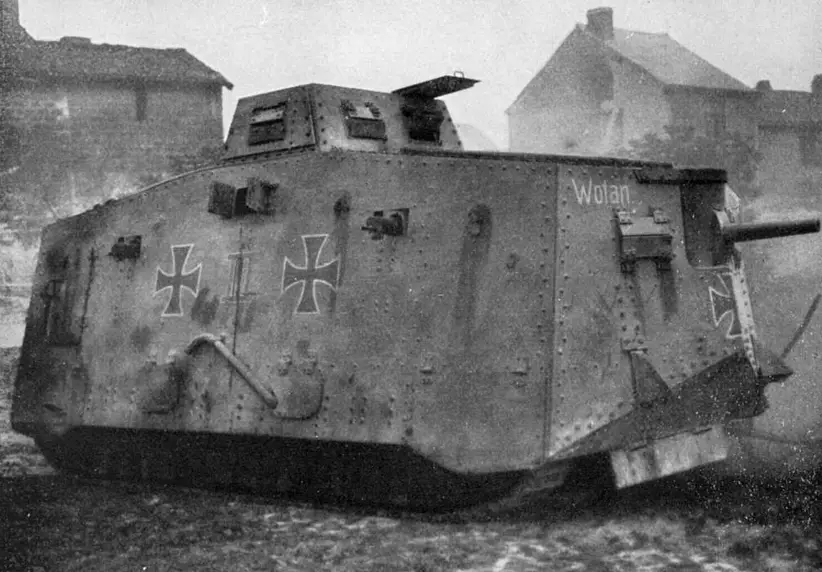
German A7V tank in World War I
Germany’s response to the British Mark series was the A7V.
Compared to the Mark I tank, the A7V was significantly faster, reaching speeds of up to 9 mph. It was also equipped with a main gun and six machine guns, offering a formidable mix of firepower.
However, Mark I and its successors had the advantage of being able to traverse difficult terrain due to their caterpillar track design. The A7V, in contrast, struggled with trenches and uneven landscapes.
From the imposing Mark I tank to the late arrival of Mark VIII, each iteration reflected a continuous process of learning and adaptation. They stood as symbols of the drive for innovation, much like the inventions of Leonardo da Vinci that pushed the boundaries of what was thought possible.
Similarly, the German A7V was a clear testament to the speed with which nations adapted to the changing nature of warfare during this period.
History has seen tanks evolve from the rudimentary designs of World War I to the technologically advanced machines of today. While there have been many formidable tanks, there have also been those that were less successful on the battlefield.
In WW1 tanks, the French FT-17 often comes to mind when discussing weaker models.
While revolutionary in its own right for introducing the classic turret design, the FT-17 was lightly armored and armed only with a machine gun or a light cannon, making it less effective against fortified positions and virtually defenseless against other tanks.
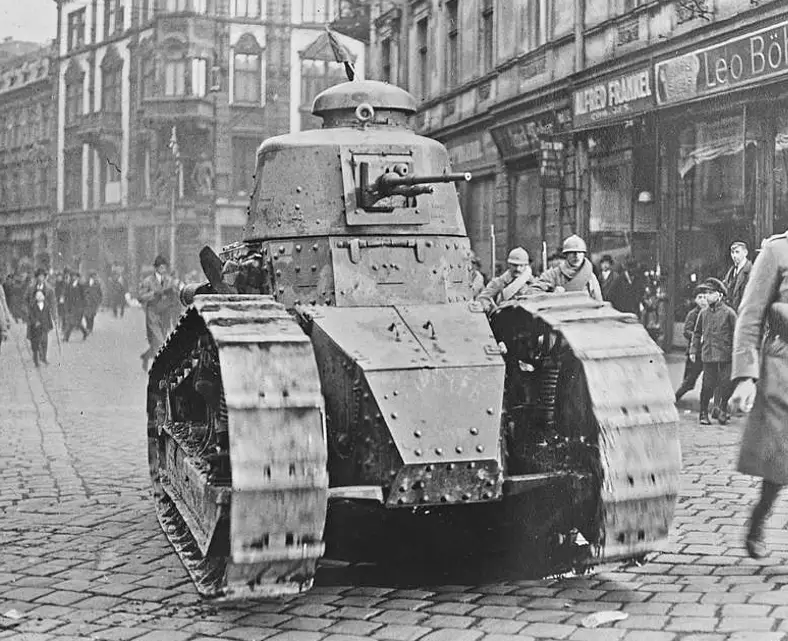
French FT-17 tank in World War I
Beyond World War I, the Italian L3/35 of World War II is often cited as one of the weakest tanks ever produced.
Despite its impressive mobility, the L3/35 was severely under-armored and under-gunned. Its twin machine guns provided little threat to enemy tanks or fortified positions.
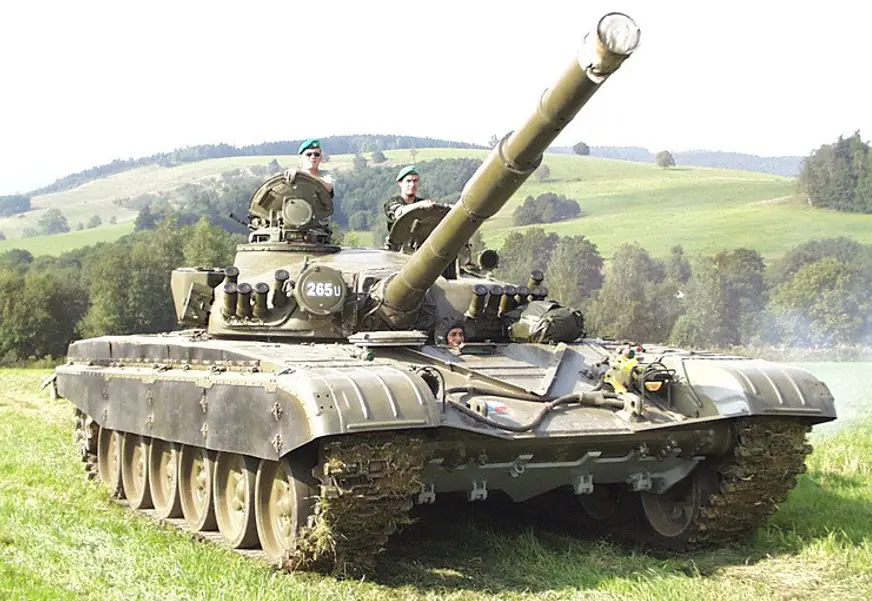
Soviet T-72 tank in World War II
The T-34, a Soviet tank from World War II, is often hailed as one of the most effective.
It combined a robust design with wide tracks (ideal for the Eastern Front’s harsh terrain), a powerful 76.2mm gun, decent speed, and sloped armor that increased the tank’s defensive capabilities.
The T-34 was a testament to the effectiveness of straightforward design and mass production, and it played a crucial role in the Soviet Union’s defensive and offensive operations.
Modern tanks in the post-WWII era, such as the T-72, stand out as one of the most effective tanks in the Soviet Union. With over 20,000 units produced since its introduction in the late 1960s, the T-72 boasts a powerful 125mm smoothbore gun, composite armor, and a compact design, making it one of history’s most widely used tanks.
The analysis of tank designs, from the weakest to the most effective, mirrors the trajectory of human innovation.
Each model, regardless of its success or failure, represents a stepping stone towards progress, much like how Leonardo da Vinci’s creations helped shape the future of human invention.
The Mark I Tank was a groundbreaking innovation in military technology during World War I. It represented the first operational combat tank, fundamentally changing the dynamics of warfare.
Designed to overcome the challenges of trench warfare, the Mark I broke new ground in armored vehicle design.
A revolutionary feature of the Mark I was its tracked design, which allowed it to cross difficult terrain. This made it an essential tool in breaking the stalemate on the Western Front.
The Mark I served as a model for future tank development by introducing armor and mobility.
Key Takeaways:
The Mark I Tank was the first combat tank used in warfare, marking a significant development in military technology. Despite its groundbreaking design, the Mark I faced limitations that influenced future improvements.
Very few Mark I tanks remain today. Most have been lost, but a couple are preserved in museums.
The Mark I Tank had mixed effectiveness. It could cross trenches but often faced mechanical issues.
Among WW1 tanks, the French Schneider FT-17 often received criticism for its poor performance and mechanical failures.
The Mark IV featured improvements over the Mark I. These include better armor and a more reliable powertrain.
The Char B1 and other prototypes from the interwar period are considered among the rarest tanks because they were produced in limited numbers.
The Mark I Tank reached a top speed of about 4 miles or approximately 6.4 kilometers per hour.
Tanks in WWI faced mechanical unreliability, slow speeds, and difficulties in rough terrains.
Very few Mark II tanks survive today. Only a handful are in museum collections.
The Mark IV tank was the most extensively used tank during World War I, with the Mark V and FT tanks also demonstrating significant effectiveness.
Just a few German Tiger I tanks remain. They are preserved in museums around the world.
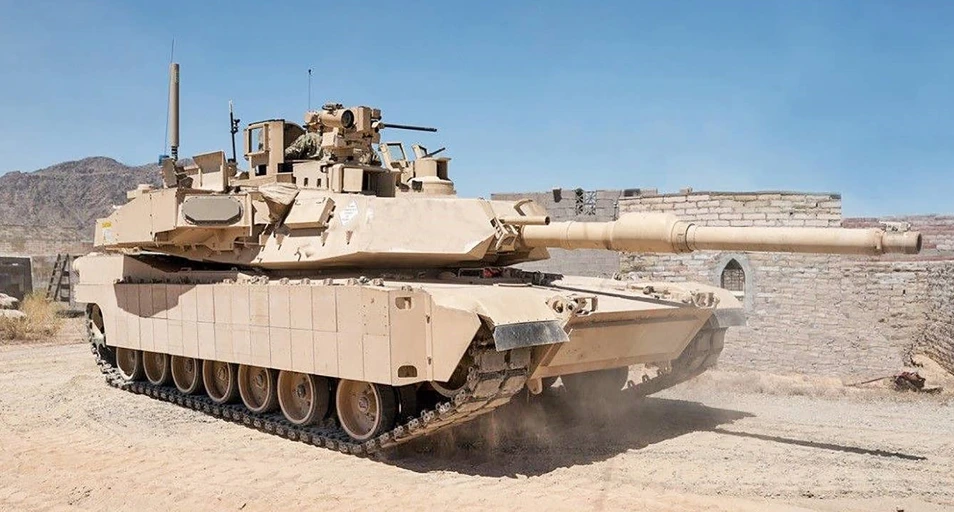
Modern tanks are a crucial component of military strength and technological advancements. When deciding which modern tank is the best today, various factors such as firepower, protection, and mobility should be considered.
The Abrams M1A2 SepV3 has advanced features like improved communication systems and active protection capabilities.
Tanks such as the German KF51 Panther and the Russian T-14 Armata also rank among the top contenders in today’s military landscape.
Each of these machines showcases impressive engineering and battlefield readiness. These tanks represent the pinnacle of modern military technology, making it worthwhile to explore the features that set them apart.
If you are interested in military technology, this article will explain why these tanks lead the field. The article will clearly understand which modern tanks dominate today’s battlefields by examining their strengths.
Modern tanks have transformed significantly over the years, serving crucial roles on the battlefield. They reflect advancements in technology and military strategy, impacting how conflicts are managed and won.
The evolution of modern tanks began with the Mark I tank, which debuted during World War I. Early tanks emphasized armored protection and mechanized movement across rough terrains.
As technology advanced, WWII saw tanks becoming faster and more powerful.
Today’s modern-day tanks have enhanced firepower and sophisticated targeting systems. They incorporate lightweight materials, increasing mobility without sacrificing defense.
Prominent tanks such as the M1 Abrams from the United States and the Leopard 2 from Germany showcase these innovations.
Tanks have evolved from slow-moving war machines to rapid-response units capable of striking with precision.
Today, modern battle tanks play a pivotal role in military operations. They are crucial for ground assaults, providing robust firepower and protection for troops.
For example, modern US tanks, like the M1 Abrams, are known for their combat effectiveness and versatility in diverse environments.
Modern tanks are not just about power; they integrate advanced technologies such as GPS navigation and automated control systems. Nations like Russia and China continuously develop sophisticated models to maintain strategic advantages.
As warfare evolves, the role of modern tanks adapts, proving their integral presence in both offensive and defensive strategies on the battlefield.
Modern tanks are a marvel of engineering. They combine advanced materials and cutting-edge technology to dominate the battlefield.
These machines focus on superior protection, adequate firepower, agility, and crew comfort to ensure peak operational efficiency.
Modern military tanks utilize composite armor that enhances protection while minimizing weight. This armor often consists of layered materials like ceramics, steel, and Kevlar, designed to absorb and deflect projectiles.
Reactive armor adds a layer of safety by exploding outward to neutralize incoming threats. Advances in modern us tanks demonstrate exceptional armor systems, such as the M1 Abrams, which uses depleted uranium for enhanced defense levels.
Cutting-edge weaponry in modern tanks underscores their strategic value. These tanks typically feature a main gun, often a smoothbore cannon, capable of firing armor-piercing rounds and guided missiles.
These firepower capabilities are complemented by machine guns for infantry defense. The Leopard 2A7, a prime example of modern German tanks, showcases a highly effective Rheinmetall 120mm gun optimized for various operations.
Modern-day tanks require potent engines to ensure quick maneuverability and strategic advantage. Turbine and diesel engines are standard, offering a blend of speed and reliability.
With advanced suspension systems, these tanks maintain stability over rough terrain. Russian modern tanks like the T-14 Armata are known for their mobility and speed, showcasing improvements in engines and transmission systems for optimal performance.
Modern tanks integrate ergonomic designs and technology for improved crew comfort. Climate control, padded seats, and advanced communication systems enhance the operational environment.
Systems like night vision, GPS, and automated tracking allow crews to remain effective during missions. The advancements in Japanese modern tanks, such as the Type 10, highlight innovations in crew-centric systems, ensuring efficiency and comfort during extended operations.
Modern tanks have become a crucial element in military strategy across various nations. Each country boasts unique designs with advanced technology, enhancing their capabilities on the battlefield.
German modern tanks are led by the Leopard 2, renowned for its powerful 120mm smoothbore cannon and excellent mobility. The United States fields the M1A2 Abrams, famous for its durable armor and advanced electronics.
Russian modern tanks, like the T-14 Armata, feature innovative technology such as an unmanned turret and active protection systems.
French modern tanks include the Leclerc, which is valued for its speed and digital fire control systems. Japan’s Type 10 offers versatile performance tailored for its varied terrain.
The Leopard 2 and the M1 Abrams are often compared due to their prominence in western armies.
The Leopard 2 emphasizes mobility and range with efficient fuel consumption. Its advanced thermal sights allow precision targeting.
The M1 Abrams focuses on strong defense, equipped with composite armor and powerful turbine engines. It excels in firepower and protection but is heavier and consumes more fuel.
Both tanks use sophisticated targeting systems, making them formidable players in modern warfare.
Table 1. Comparison between Leopard 2 and Abrams tanks
| Features | Leopard 2 (Germany) | Abrams (USA) |
|---|---|---|
| Nickname | Swift Predator | Ironclad Juggernaut |
| Manufacturer | Germany | United States |
| Main Gun | 120mm smoothbore gun | 120mm smoothbore gun |
| Special Focus | Speed, Agility, and High-Tech Firepower | Superior Armor and Survivability |
| Mobility | Superior – thanks to a powerful multi-fuel engine and advanced suspension system | High – but not specifically highlighted in comparison to Leopard 2 |
| Advanced Tech | Digital fire control systems, advanced optics, and sophisticated thermal imaging system | Advanced fire control system, sensors, and targeting system |
| Armor | Not specified | Advanced composite armor (Chobham armor) |
| Survivability | Not specifically highlighted | High – designed to withstand high-explosive anti-tank (HEAT) rounds and kinetic energy penetrators |
| Ability to Engage Targets | High accuracy in various combat conditions | Accurate in both day and night conditions, can track and engage moving targets while on the move |
| Terrain Versatility | Can traverse challenging terrain at high speeds | Not specified |
Modern tank designs push boundaries with technology like artificial intelligence and stealth capability.
For instance, the Merkava Mk 4 Barak incorporates advanced AI systems that streamline operational tasks.
The PL-01 from Poland showcases a futuristic design with modular armor and an infrared suppression system. Such innovations aim to enhance survivability and adaptability in diverse combat environments.
Formidable tanks with a reputation for dominance include the T-14 Armata, which is known for its cutting-edge tech and protection systems.
The M1A2 Abrams holds a prominent place due to its impressive combat record.
The Leopard 2’s versatility and robust defensive features make it a fearsome opponent. Tanks like these define military might and technological progression in modern warfare.
Modern tanks continue to evolve with new technologies that enhance their capabilities on the battlefield. Two significant areas of advancement include active protection systems and the integration of unmanned ground vehicles.
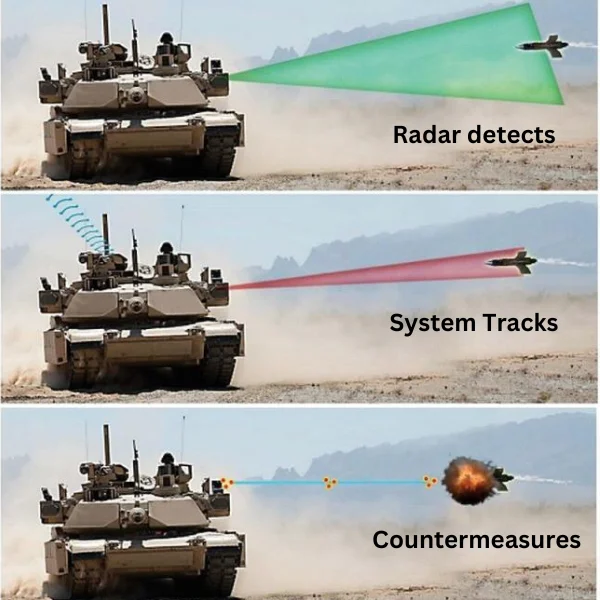
How to deal with an incoming threat by the Trophy APS system
Active protection systems (APS) safeguard modern tanks against incoming threats. These systems detect, track, and neutralize projectiles such as anti-tank missiles and rockets before they can cause harm.
For example, the Israeli Trophy system uses radar and sensors to identify threats and counterattacks by launching small projectiles to intercept them.
US modern tanks like the M1 Abrams are adopting such technologies, significantly increasing their survivability. Russian modern tanks, notably the T-14 Armata, also feature advanced APS capabilities.
This technology is a game-changer, providing extra defense layers and adapting to various war environments.
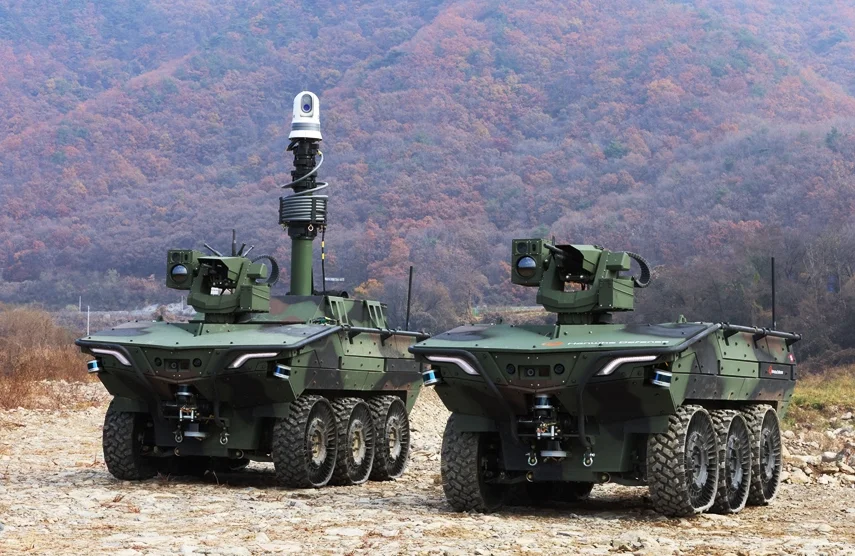
Arion-SMET UGV for supporting infantry operations such as transporting munition and weapons by US Army
Integrating unmanned ground vehicles (UGVs) with modern main battle tanks transforms operational scenarios. UGVs can perform various tasks, including reconnaissance, logistics support, and active conflict engagement.
By working alongside modern military tanks, UGVs help reduce the risk to human soldiers, allowing remote operations in dangerous zones.
Modern US tanks, for instance, are increasingly tested for compatibility with UGVs, expanding their tactical options on the battlefield. The military potential of UGVs is vast, ranging from resupply missions to combat support, and represents a future step in automating and enhancing tank warfare capabilities.
Modern tanks vary significantly in design and capability, depending on country-specific needs and technological advancements. Key issues include tank-to-tank interactions and how defense budgets shape these innovations.
A few models often come to mind when comparing tanks: the M1A2 Abrams, Leopard 2, and the T-14 Armata.
The M1A2 Abrams is a modern US tank known for its armor and advanced fire control systems. German modern tanks like the Leopard 2 are recognized for their precision engineering and versatility on the battlefield.
Russian modern tanks like the T-14 Armata feature advanced technology like unmanned turrets and heavy armor.
Modern Japanese tanks, like the Type 10, offer agility and cutting-edge electronics, making them suitable for maneuver warfare. Each tank model has its strengths: firepower, armor, or mobility. The choice often depends on the operational needs and strategy of the military using them.
Global defense spending plays a significant role in the design and deployment of these tanks.
Countries with large budgets, such as the United States, Germany, and Russia, can afford experimental technologies for their modern military tanks.
For instance, the development of the T-14 Armata reflects Russia’s investment in military innovation.
Germany’s Leopard 2 is another example of a tank benefiting from a robust defense budget.
In contrast, countries with lower budgets may focus on upgrading existing models rather than developing new ones. While some nations field the most modern tanks, others rely on older but improved versions.
Modern tanks play a crucial role in military strategy today. Known for their advanced technology and robust design, these machines combine firepower, armor, and mobility to become powerful assets on the battlefield.
Several tanks are noted for their excellence. For example, the Leopard 2 is highly regarded in Europe for its ability to combat high-tech opponents and balance speed and protection.
The M1A2C Abrams from the U.S. boasts better armor, improved mobility, and superior fire control systems. Its main gun can penetrate most armor types, making it a formidable adversary.
Different regions have their favorites. The Merkava V is preferred in Israel for its adaptability to local challenges. Meanwhile, Russian field models like the T-14 Armata and T-90M emphasize cutting-edge features and versatility.
Key Takeaways: Modern tanks, like the K2 Black Panther from Korea, integrate technology and performance to address diverse military needs. Rapid advancements suggest continued evolution in tank design and capability.
Modern tanks vary widely in design and capabilities. This section explores various aspects of current military tanks, including comparisons and advancements.
The most modern tanks include the T-14 Armata and the M1A2 SEP V3 Abrams. These tanks feature advanced technology, such as upgraded armor and improved targeting systems. They represent the forefront of tank innovation today.
Opinions on the best modern tank vary, but the M1A2C Abrams is often highlighted for its mobility and armor. Another contender is the Challenger 2, which is known for its combat experience. These tanks are widely recognized in military circles for their effectiveness.
The T-90 is less expensive and lighter, offering specific advantages in different terrains. However, the Abrams are noted for their superior armor and firepower. Each tank has unique strengths, making them suitable for other roles.
Fourth-generation tanks include the T-14 Armata. This tank features cutting-edge technologies like unmanned turrets, and it is a step up from previous generations with advanced automation and protection.
Currently, the M1A2 Abrams is often regarded as the top tank globally. Its robust design and combat performance set high standards and remain a prominent choice for many armed forces.
The US has lost Abrams tanks in combat, though such losses are relatively rare. Situations in conflict zones have led to damage or destruction. These losses often result from anti-tank missiles or IEDs.
The Abrams tank is praised for its strong armor and firepower. Its advanced electronics and mobility make it versatile in various terrains. The tank’s reliability and continuous upgrades contribute to its excellence.
Ukraine has not operated Abrams tanks extensively, so verifiable loss data is limited. However, current military engagements and aid might alter their usage and potential losses in the future.
Countries like the United States and Russia maintain some of the best tanks, such as the M1A2 Abrams and T-14 Armata. These tanks showcase superior military technology. The diverse strengths of these models make them highly regarded internationally.
Yes, America is working on developing new tank models. These projects aim to integrate future-ready technologies.
Continued research and development ensure that American tanks remain competitive globally.
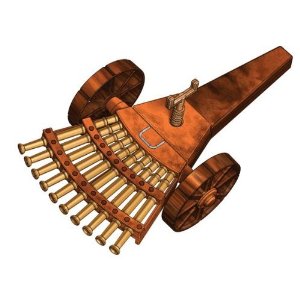

Leonardo da Vinci machine gun model
The Leonardo da Vinci machine gun is a fascinating example of ingenuity and foresight from the Renaissance era. You may find yourself intrigued by the idea of a famous artist contributing to weapons development.
This article will explore how Leonardo da Vinci’s imaginative designs paved the way for future advancements in weaponry.
Leonardo’s machine gun, also known as the 33-barreled organ, was a unique prototype that aimed to solve the slow reloading time of traditional firearms. By arranging multiple barrels in a fan shape, it allowed for rapid succession firing, which was groundbreaking for its time.
Though never built, Leonardo’s design was a precursor to modern automatic firearms.
Beyond just the machine gun, this inventive mind conceived various other war machines, including armored cars and giant crossbows. His work as a military engineer demonstrated his unparalleled ability to merge art with practical technology applications.
Enthusiasts of history and innovation will appreciate how his ideas influence designs in contemporary weapon systems.
Leonardo da Vinci’s inventive genius during the Renaissance led to many groundbreaking ideas. His concepts for military technology, such as the machine gun, showcased his imaginative approach to warfare.
During the Renaissance, Leonardo da Vinci emerged as one of the most influential figures in art, science, and engineering. His ideas often included significant advancements in technology.
The Leonardo da Vinci machine gun is a prime example of his foresight in modern weaponry. Developed in the 15th century, it proposed a rotating barrel system allowing continuous firing without reloading delays. This idea laid the groundwork for future advancements in artillery.
The Renaissance period was marked by a desire to explore new ideas, and da Vinci’s work reflected this spirit of innovation and curiosity. His visionary designs were not limited to weapons but also included concepts like the Leonardo da Vinci flying machine and the much-discussed Leonardo da Vinci tank.
Leonardo da Vinci’s military designs were ahead of their time, encompassing a range of da Vinci war machines. His work demonstrated a deep understanding of engineering principles, which he applied to create innovative solutions for military challenges.
Among his creations, the Leonardo da Vinci machine gun stood out for its unique approach. Featuring a 33-barreled organ gun, it aimed to improve firing rates and efficiency.
While these designs were revolutionary, they remained conceptual during his lifetime. This fascination with engineering extended beyond weapons, influencing later inventors and paving the way for future advancements in military technology.
Leonardo da Vinci’s machine gun showcases his remarkable ability to envision complex mechanical systems. This innovation foreshadowed the evolution of modern artillery and highlighted his forward-thinking approach to weaponry.
The da Vinci machine gun, often compared to the 33-barrel organ, was a marvel of engineering for its time. It featured multiple small-caliber barrels arranged in a fan shape, allowing for simultaneous firing. This design increased the rate of shots and offered a wide spread of bullets.
A crucial feature was its mobility. The gun’s carriage had wheels, enabling easy movement on the battlefield.
Leonardo’s sketches detailed loading mechanisms and the elevation adjustments necessary for aiming. The concept was to overwhelm enemies with a barrage of firepower, a strategy that still resonates in modern artillery systems.
Leonardo’s design was ahead of its time in terms of military technology. His war machines, like this machine gun, were part of a broader vision that included other ingenious inventions such as the Leonardo da Vinci tank and the parachute Leonardo da Vinci.
These devices underscore his understanding of the dynamics of war and defense mechanisms.
The concept of rapid-fire artillery, which was not fully realized until centuries later, highlights Leonardo’s pioneering thought. His machine gun laid the groundwork for future developments in weaponry.
Leonardo da Vinci’s machine gun exemplifies his visionary art, blending mechanics and aesthetics. His sketches reflect his innovative approach to engineering and showcase early ideas that predate modern firearms.
Within the Codex Atlanticus, Leonardo da Vinci created detailed machine gun designs featuring multiple barrels. This collection of drawings, part of the Biblioteca Ambrosiana in Milan, includes a 33-barreled organ gun resembling organ pipes aligned together. These sketches highlight his artistic finesse and his ability to envision warfare technology.
Da Vinci focused on machine guns and explored other military inventions, such as the Leonardo da Vinci cannon and various war machines. His designs were intended to improve firing rates in conflict situations.
Though his machine gun concept was never built, it paved the way for modern engineering discussions.
Leonardo’s work exhibits a seamless fusion of art and science. His drawings stand as artistic representations that reveal his unique perspective on innovation. This blend of creativity and engineering showcases da Vinci’s profound impact on art and technology.
Recreating Leonardo da Vinci’s machine gun involves understanding and adapting his original designs for modern construction. This task appeals to history enthusiasts and engineers who appreciate da Vinci’s ingenuity.
Leonardo da Vinci’s machine gun, sometimes called a rapid-fire crossbow, was detailed in his famous notebook, the Codex Atlanticus. Enthusiasts and historians have recreated this design to explore its practicality. The machine gun aimed to fire multiple shots rapidly, an idea unique to da Vinci’s time.
Producing this machine includes using materials and methods that mirror the 16th-century vision.
The Leonardo3 Museum provides insights into these machines by displaying digital and physical models.
Their exhibits allow visitors to interact with da Vinci’s concepts, ranging from crossbow designs to flying machines. Building these models deepens our appreciation for his inventive genius and showcases how his ideas, such as the Leonardo da Vinci machine gun, remain significant advancements in engineering.
Leonardo da Vinci’s machine gun designs showcase his remarkable foresight and creativity in weapon innovation. His concept of a multi-barreled weapon addressed the slow reloading times of early firearms.
Several of his designs, like the 33-barreled organ gun, can be seen as prototypes for modern artillery.
Leonardo’s innovative use of multiple cannons firing in succession demonstrated his deep understanding of battlefield needs.
Despite their potential, these designs mainly remained theoretical due to technological and resource constraints. However, his ideas did influence later generations.
Key Takeaways: Leonardo da Vinci’s ideas on machine guns were ahead of his time, laying the groundwork for future advancements in rapid-fire weaponry. His inventive spirit continues to inspire engineers and inventors today.
Leonardo da Vinci’s interest in military technology led him to create designs for various machines. His designs include a machine gun concept known as the 33-barreled organ, but many of his inventions faced challenges in practicality and execution.
Leonardo da Vinci designed a concept for a machine gun called the 33-barreled organ. This design featured multiple barrels arranged in rows to allow rapid firing. However, he never actually built a functioning model.
The 33-barreled organ was an ambitious design never constructed in da Vinci’s time. The technology and materials available during the Renaissance were insufficient to bring this design to life. However, it remains a concept that demonstrates his innovative thinking.
Leonardo da Vinci did not invent the ballista, as it was an ancient missile weapon the Greeks and Romans used. However, he did create designs that improved upon the existing ballista technology. His version featured enhancements for increased power and accuracy.
Leonardo da Vinci designed various military machines, including a tank, a giant crossbow, and a machine gun. He also conceptualized an armored vehicle resembling a modern tank. These designs showcased his creativity and vision for military innovation.
Many of Leonardo da Vinci’s military machines remained conceptual and were not built during his lifetime. Practical limitations and the complexity of his designs often prevented them from being realized.
Leonardo’s catapult design used tension to launch projectiles. It featured a sling that held the projectile, which was then launched by releasing the tension in a coiled rope or spring. This design aimed to enhance the range and power of traditional catapults.
Leonardo da Vinci is credited with designing a mechanical knight, often regarded as one of the earliest robots. This machine could mimic human motions, such as sitting, standing, and moving its arms. However, it was not built during his lifetime.
Leonardo da Vinci did not invent the grenade, but he did sketch designs for explosive devices. One of his ideas was a cylindrical grenade filled with powder. This illustrates his interest in and contributions to early warfare concepts.
Leonardo da Vinci sketched a design for a flying machine known as the “aerial screw.” This design resembled a primitive helicopter with a sizeable screw-shaped rotor. Though it was never built, it was an early exploration of vertical flight.
Leonardo da Vinci’s tank design was made of wood and featured a protective shell reinforced with metal plates. The vehicle was equipped with various cannons and designed to move on wheels. However, mechanical limitations prevented it from being built.
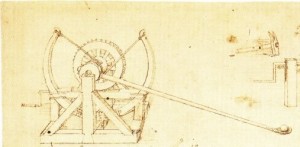
Leonardo da Vinci Catapult is an intriguing invention. Its design stands out because it combines artistic creativity with scientific precision. The catapult featured a leaf spring system and a rotating drum mechanism, improving the power and efficiency of traditional catapults.
Leonardo da Vinci‘s innovative approach to warfare and defense fascinates those who are curious about the future applications and impacts of his catapult.
His designs influenced military technology and contributed to the broader engineering field. The Leonardo da Vinci Catapult allows visitors to explore these revolutionary concepts more deeply.
This invention is a testament to da Vinci’s forward-thinking mindset, reflecting his view of the relationship between form and function.
Studying his improvements to this device reveals the extensive knowledge and creativity he applied to his work.
Leonardo da Vinci, a prominent figure of the Renaissance, contributed significantly to science and engineering. His inventions, such as the Leonardo da Vinci Catapult, reflect the era’s interest in military advancements and innovation.
Europe experienced a surge in cultural, scientific, and technological progress during the Renaissance. This period was marked by a renewed interest in classical knowledge and an eagerness to innovate. Military technology saw remarkable advancements during this time.
The ancient Greek catapults had been used for centuries, but their designs evolved. Leonardo da Vinci, intrigued by these ancient mechanical devices, developed his version.
The Leonardo da Vinci Catapult improved previous designs by incorporating innovative features to increase its power and range.
Military engineering was critical during the Renaissance, as conflicts and territorial expansions were rampant. Da Vinci’s work stood out because he combined his artistic skills with practical engineering, resulting in sophisticated designs ahead of his time.
Extensively studied catapult models provide insight into his genius and the period’s technological capabilities.
Leonardo da Vinci’s role extended beyond that of an artist. He was also a visionary engineer and inventor. He applied his understanding of mechanics and physics to create artistic and functional designs.
Da Vinci’s inventive genius is evident in designs like the armored vehicle and the Leonardo da Vinci Catapult. Though many of his inventions were not built during his lifetime, they influenced later developments in engineering. Leonardo’s notebooks reveal detailed sketches and ideas that often blended creativity with scientific exploration.
His ability to envision machines like the catapult, which he innovatively designed to suit the needs of his time, showcases his impact. Leonardo’s legacy as an engineer has left an indelible mark on technological advancements, inspiring generations of inventors.
Leonardo da Vinci’s catapult showcases his ingenuity in reimagining medieval catapult design with improved efficiency and power. By studying existing mechanics, he aimed to enhance projectile launching by exploring innovative materials and mechanisms.
Leonardo da Vinci created detailed sketches and notes demonstrating his visionary approach to catapult design. Although his catapult was not an entirely new invention, he sought to refine existing concepts through thoughtful adjustments. One of his designs included a double-leaf spring mechanism, allowing increased tension and power.
His sketches were precision-oriented, considering force vectors and projectile trajectories. Careful calculations ensured stability and balance, which is vital for an effective launch. Although his designs were not built during his lifetime, they offer insight into his mechanical brilliance and forward-thinking approach.
Leonardo da Vinci’s catapult’s core mechanics revolved around tension and torque-enhancing launching force. Unlike traditional torsion-based catapults, it utilized a spring leaf mechanism. This adjustment allowed for more controlled and powerful launches, increasing the range and impact of projectiles.
Leonardo also focused on improving the loading and firing mechanism. His designs aimed to simplify the process, making it more efficient for potential wartime use.
His understanding of torque and tension motivated this enhancement, ensuring each component worked symmetrically. As a result, da Vinci’s catapult demonstrated artistic prowess and an advanced grasp of engineering principles.
Leonardo da Vinci’s catapult showcases the innovative use of materials and construction techniques. Its design reflects a blend of wood and rope preferences, and its unique approach to tension and counterweight systems enhanced its efficiency as a war machine.
Leonardo da Vinci’s catapult relied on carefully selected wood and rope, which were vital for its functionality. Hardwoods like oak were preferred for their durability and strength, which is essential for withstanding the stress of launching projectiles. Softwoods, despite being lighter, were less common in such applications.
Ropes made from natural fibers like hemp were flexible and strong. Hemp’s elasticity was crucial for efficiently absorbing and releasing energy during the firing process. The combination of hardwood for structural components and hemp for tension elements ensured a balance between strength and flexibility, helping to maximize the power and range of the projectiles.
Leonardo da Vinci’s approach to tension and counterweight systems in his catapult design was distinctive. These mechanisms were crucial for the catapult’s ability to launch projectiles.
By optimizing the tension in the ropes and employing counterweights, the da Vinci catapult could achieve significant force and distance.
Tension was carefully adjusted by winding ropes, a method derived from earlier torsion-based catapults, such as the ancient Greek models. This tension-powered mechanism allowed controlled and precise releases, while counterweights provided the necessary balance to maintain stability during operation.
This integrated system of tension and counterweights exemplifies Leonardo’s ingenuity. He melded ancient catapult principles with his inventive enhancements, and this thoughtfulness in design and construction enabled his catapult to perform effectively as a formidable weapon at the time.
Leonardo da Vinci’s innovative designs transformed the landscape of military technology. His work on war machinery, such as the da Vinci catapult, provided fresh insights into the capabilities and mechanisms of siege engines.
Leonardo da Vinci’s contributions went beyond weaponry. He influenced the broader field of military engineering. His sketches, which include detailed mechanisms and structural designs, inspired future generations to explore new engineering possibilities.
The da Vinci catapult showcased how art and science could converge to improve military technology. His emphasis on precision and efficiency paved the way for modern engineering strategies used in warfare.
By focusing on practicality alongside creativity, da Vinci’s inventions encouraged a shift from brute force to more calculated and efficient methods of attack, altering the course of military strategy development. His work on siege engines remains a testament to his profound impact on military design and engineering.
The question of who invented the catapult takes us back to the ancient world. The first known catapults were developed in ancient Greece in the 4th century BC, specifically by a Syracuse engineer named Dionysius the Elder.
Unlike the da Vinci catapult, these early devices relied on torsion power from twisted ropes or sinew rather than tension or counterweights. This type of catapult, also known as a mangonel catapult, used the stored energy in the twisted ropes to hurl projectiles toward the enemy.
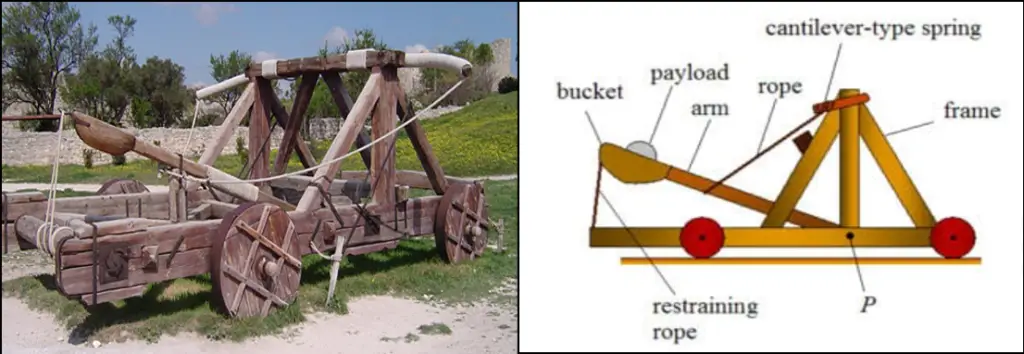
Mangonel Catapult
As centuries passed, catapult design blueprints saw significant changes. Greek and Roman engineers refined and diversified catapult designs, introducing new mechanisms like the ballista and onager.
It’s fascinating to compare these classical designs with the more sophisticated da Vinci catapult, a testament to the evolution of engineering over the millennia.
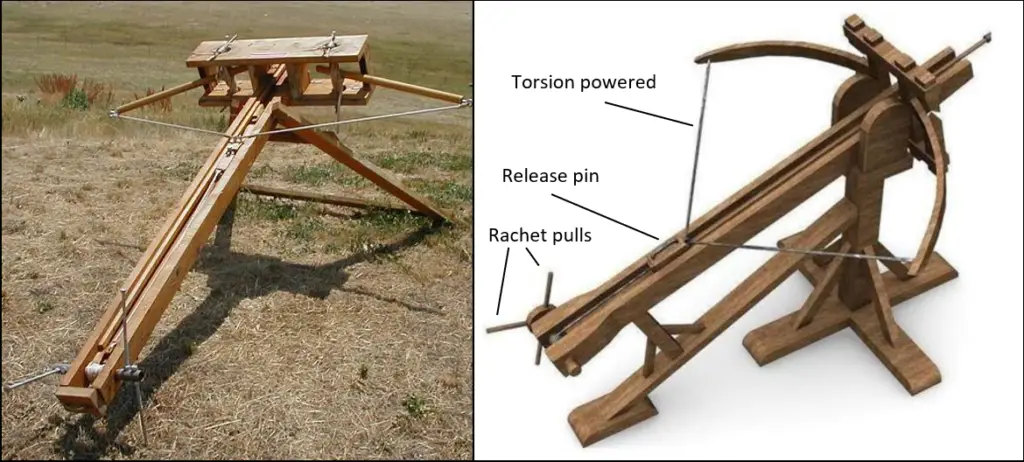
Ballista Catapult
In East Asia, the Mongolians advanced catapult technology by creating the Mongolian catapult, or Hwacha. This innovation could fire multiple projectiles at once, a stark contrast to the single-projectile designs common in the West.
Catapult technology saw another shift during the Middle Ages. The most prominent type of catapult used during this period was the trebuchet. This siege weapon used a counterweight mechanism, unlike the tension-based design of the da Vinci catapult.
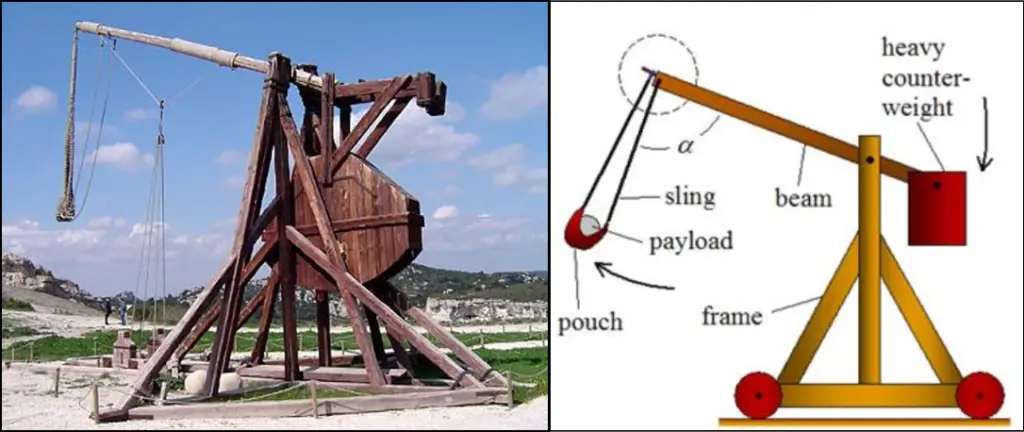
Trebuchet Catapult
Trebuchets were the apex of medieval siege technology, capable of hurling large projectiles at great distances. The introduction of counterweight technology marked a significant departure from the ancient torsion catapult design, leading to more powerful and efficient siege engines.
Despite the differences in design and the centuries that separate them, the trebuchet and the Leonardo da Vinci catapult share a common purpose: to use mechanical advantage to achieve power and precision beyond human capabilities.
Here are five fun facts about catapults that might surprise you:
There are 4 Leonardo da Vinci catapult facts that might not be commonly known:
In contrast to their original role as siege engines, what is a catapult used for in modern times is remarkably diverse. The physics principles that catapults employ have found applications in various modern technologies:
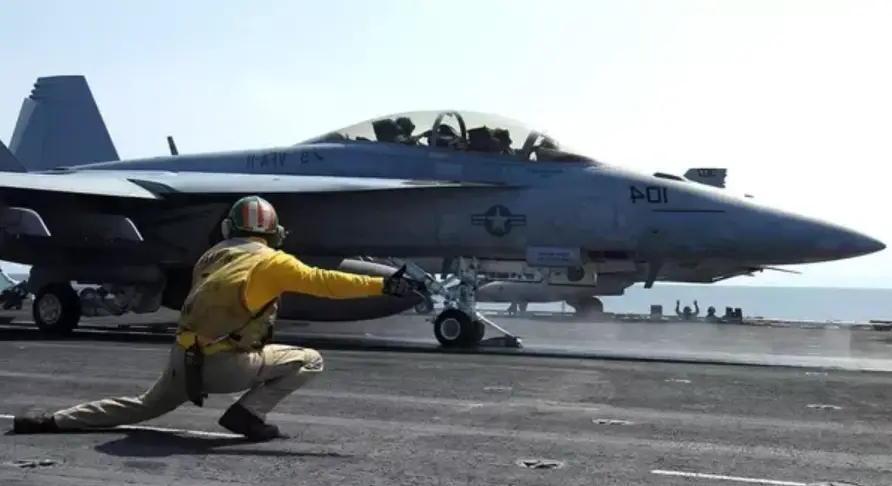
Aircraft Catapult in Aircraft Carrier
Modern efforts to recreate Leonardo da Vinci’s catapult bridge the past and the present. These reconstructions offer practical insights into historical siege technologies and engaging educational experiences for learners.
Enthusiasts and historians today are captivated by the task of bringing da Vinci’s catapult to life. They aim to precisely replicate da Vinci’s intricate designs using advanced techniques such as 3D printing and laser cutting sites. Instructables detail steps to construct these models, making them accessible to hobbyists and educators.
These projects highlight da Vinci’s work’s elegance while showcasing improvements in design and function over traditional catapult weapon systems. These reconstructions show a clear link between ancient engineering concepts and modern manufacturing capabilities.
Da Vinci catapult replicas serve as valuable tools in education. They bring to life the history of catapults, connecting students with ancient technologies and the evolution of military strategies.
Schools and museums often use these models to teach physics and engineering principles. Through hands-on interaction, tension, force, and trajectory become tangible.
For children and students, working with these replicas fosters curiosity. Educational resources like those found on Teaching Expertise provide activities that nurture creative thinking, marrying historical context with scientific understanding. This makes learning about the catapult’s ancient Greek origins and their application in warfare entertaining and informative.
Leonardo da Vinci’s catapult is a testament to his endless curiosity and genius. His variations on the traditional catapult design showed his willingness to rethink and improve upon existing technologies.
These improvements highlighted his interest in mechanics and physics, which were ahead of his time.
Leonardo explored different concepts, like using leaf springs to enhance throwing power.
These sketches demonstrated his understanding of torque and tension forces, paving the way for more dynamic catapult designs.
Though da Vinci’s catapult designs were not widely adopted during his lifetime, they contributed to technological progress and revealed his innovative spirit.
This aspect of his work mirrors his approach to numerous inventions, where creativity met science.
Key Takeaways:
Leonardo’s fusion of art and science continues to inspire modern engineering and design, offering insights that remain relevant today.
Catapults have fascinated people for centuries, from ancient war machines to innovative designs by geniuses like Leonardo da Vinci.
These devices illustrate the evolution of engineering, highlighting various types and their historical significance.
The ancient Greeks initially invented the catapult, specifically by a Syracuse engineer named Dionysius the Elder. They developed it in the Fourth Century BCE to enhance their siege warfare techniques.
The first known catapults were invented around 399 BCE. They revolutionized how armies conducted sieges during battles.
A catapult stores potential energy in a tension arm or through rope twisting.
This energy propels a projectile across long distances with great force when released.
The Greeks are credited with inventing the catapult around 399 BCE. This invention provided a major advantage in warfare at the time.
The mangonel catapult was developed in the early Middle Ages, around the 6th century. It was designed to use torsion and tension to produce maximum force.
The trebuchet, which appeared in the 12th century, is considered one of the most potent medieval siege engines. It used a counterweight system to hurl projectiles.
Another Roman innovation, the onager, was developed around the 4th century CE. Its unique mechanism distinguished it from prior catapults.
The aircraft carrier catapult, introduced in the early 1900s, was a 20th-century invention. It launched aircraft from naval ships using steam or electromagnetic systems.
The Greeks first used torsion catapults in the 4th century BCE. They utilized twisted cords to generate powerful launching forces.
There are five main types of catapults. These are ballista, mangonel, onager, trebuchet, and torsion catapults. Each type demonstrates unique engineering approaches and uses throughout history.